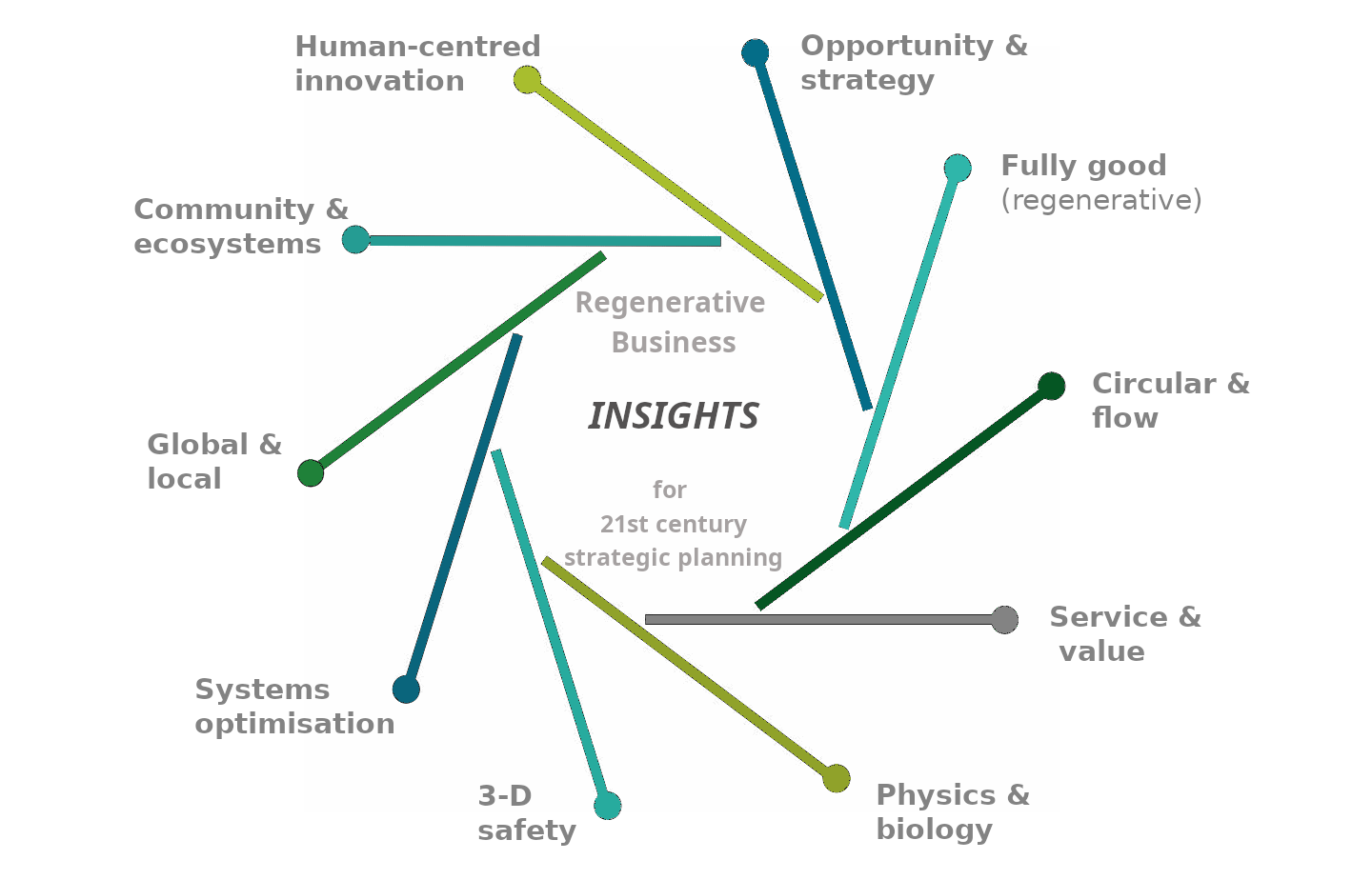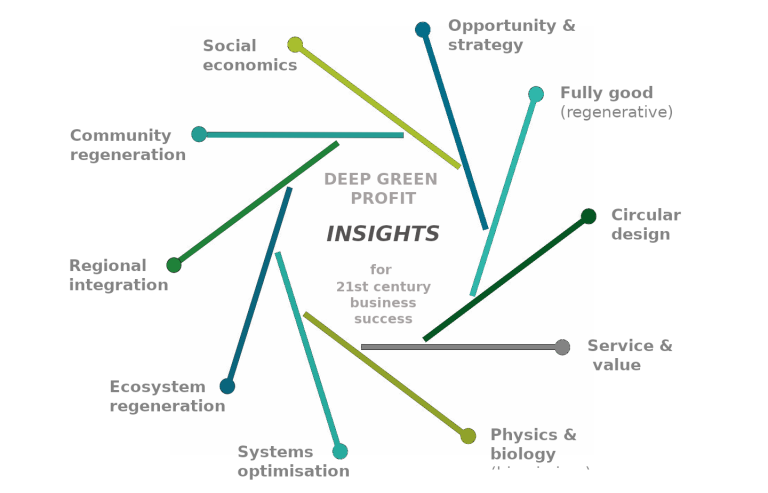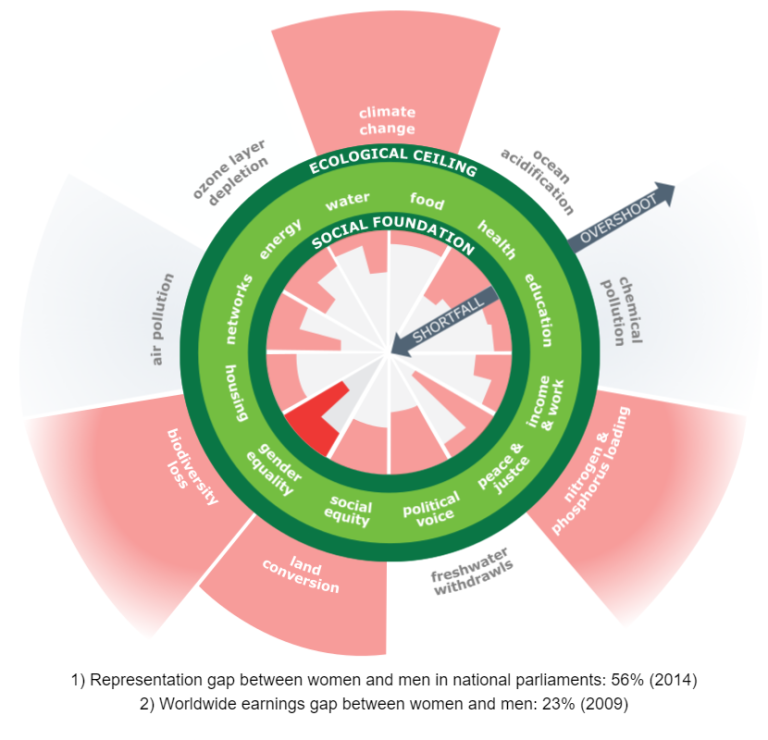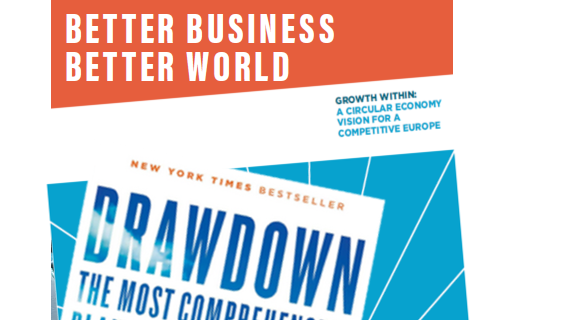Regenerative Design Basics
(Originally published: 1 June 2020)
Innovators and Entrepreneurs have been working on Regenerative Business principles for many decades. The rate of innovation ramped up in the 1970s, after The Limits To Growth was published – but the first solar panel installation dates back to the 1880s…
Some key approaches have evolved that describe 10 core principles of Regenerative Business strategy and design. There are different development streams and different brands have developed around each principle, but overall, these10 key trends are evident:
1. Orient to opportunity – do WELL by doing good
Why? Historically, sustainability has been treated by most organisations as a cost and an obligation. However, that’s out-of-date thinking – and in the third decade of the 21st century, it’s thinking that hides innovation opportunities.
There’s been an unspoken assumption that “caring for the environment and communities is up to government”. (Somewhat unreasonable when extract/emit/exploit industry has 5x the revenue of governments and NFPs combined – and then dumps its hard-to-process refuse into ecosystems and communities.)
The 1960s notion that “business should only care for its shareholders” is well past its useby – and hides substantial, long term strategic opportunities.
Fixing bad design after construction is expensive, difficult and a whole lot of hassle. Fixing the harm done by business before it happens (and gaining the innovation savings) increasingly lies with business – and is rich in opportunity IF YOU LOOK FOR IT.
Early adopters like Patagonia have been joined by business innovators from industry and commerce.
Today’s strategies and technologies increasingly enable organisations to design “innovation for regeneration” into their core business model as OPPORTUNITY. There is growing recognition that isolating “doing good” inside compliance, reporting and administration is leaving money on the table.
Over the long term, doing business that’s respectful of the systems it’s dependent is on inherently better for the bottom line. Designing to use more renewable resources, to regenerate ecosystems and to restore communities is increasingly recognised as driving efficiency, innovation and staff engagement.
And the benefits are getting bigger as our systems understanding and our technology get smarter.
Circular Economy innovation is estimated to offer business $4.5 trillion in savings by 2030.
Project Drawdown‘s modelling of the top evidence-based commercial climate solutions ALREADY scaling globally identifies savings of $80-$140 trillion by 2050 – AND the solutions deliver on at least 15 of the 17 UN Sustainable Development Goals.
The Interface Corporation makes commercial carpets, and in 1995 they declared sustainability a core business strategy. In the first 12 years of their innovation initiative to “climate Mount Sustainability” they put $393,000,000 on their bottom line.
Today, Interface have achieved Net Zero globally and are now busy with a regenerative, supply chain wide Climate Takeback program that includes building factories that act like forests.
Smaller, more nimble businesses are playing an increasing role as they can often respond quickly to market shifts and opportunities. They’re not bound to external reporting cycles and market pressure – which makes it easier to pivot.
Increasingly, business initiatives will be expected to deliver REAL social, environmental and financial ROIs. Those that genuinely lead – small and large – will have a first mover advantage.
This has been an ongoing field of innovation for decades – resulting in commercial opportunities today. Some other people, approaches and movements you may recognise include:
- Afdhel Aziz and Bobby Jones in the book(s) Good is the New Cool
- Michael Porter and Shared Value Economics
- Ray Anderson’s story of Interface in Business Lessons from a Radical Industrialist
2. Design for regeneration
We’re out of time to design for “less harm” and “zero impact” – and setting these goals doesn’t maximise human creativity, human ambition or systems potential.
The scale and variety of harms accumulating in depleted ecosystems and fractured communities is massive – so much so that today’s innovators and entrepreneurs are building solutions that actively restore and regenerate ecosystems and communities.
It’s against human nature to be motivated by scarcity and loss. PLUS goals around “reduce harm” and “zero” tend to run into the law of diminishing returns – the closer you get to zero, the more it costs. (Often because it puts the focus on the existing process, not smarter innovation based on end goals.)
Regenerative approaches that put life at the heart of every decision unleash a tsunami of engagement, creativity and business innovation.
Some starting points:
- Paul Hawken, Project Regeneration and his latest bestseller REGENERATION: Ending the Climate Crisis in One Generation.
- Kate Raworth, her book Doughnut Economics and the Doughnut Economics Action Lab.
3. Close the loop on resource flows with a Circular Economy
Humans have been extracting resources out of our host ecosystems and dumping our leavings back into it since the Iron Age.
What’s increasingly expensive is the 1-way mine/make/use/dump mindset behind today’s industry. Products aren’t made for reuse and remanufacture, so they aren’t designed for remanufacture. Supply chains don’t capture and reuse the majority of materials. Materials made for “least cost to produce” end up toxic hybrids never designed for recycling or remanufacture – and massively expensive to re-process.
So it looks cheaper to mine virgin materials from ecosystems and dump waste into them.
That was the 20th century – and we have a wealth of much smarter solutions. Today, it’s feasible – and increasingly cost-effective – that all materials can be designed as either technical nutrients that industrial systems can upcycle continuously or biological nutrients we can safely leave ecosystems to compost.
Building systems that safely reprocess technical nutrients is far less expensive (over time) than endlessly extracting virgin resources from fragile, finite ecosystems. A whole span of OHS, EHS, HAZMAT, waste disposal and other costs evaporate.
Some people, approaches and movements you may recognise are:
- Bill McDonough and Michael Braungart’s work on Cradle to Cradle Product Innovation, including books The Upcycle and Cradle to Cradle
- Dame Ellen Macarthur who founded a foundation for The Circular Economy
4. Service-based economy
Move the generation of business value away from “growth in product sales” to “growth in value delivered.”
When people buy a product, they buy the value it delivers. People who buy air conditioners want to be cool; people who buy televisions want to be entertained. Streaming services have turned music and movies from products (tapes and disks) into services – it’s a trend increasingly supported through digital technology.
For maximum profit, design better ways to deliver more customer value – not just cheaper ways to make the product. The strategic thinking required to consider value and markets can re-invent business offerings.
When you sell the value your product delivers, you gain much better control of the innovation process – and you can innovate without having to go through complex sales processes. Commercial air-conditioning is beginning to be sold as a service – leaving the suppliers free to do equipment upgrades and test alternative strategies.
Some people, approaches and movements you may recognise are::
- Womack and Jones in Lean Solutions
- Paul Hawken et al in Natural Capitalism
- Chan Kim and Renée Mauborgne pull apart service and value in Blue Ocean Strategy
5. Biology and physics, not just engineering
Until recently, our production technologies have been predominantly high-energy, high-pollutant mechanical and chemical engineering principles. They’ve been inherited from foundries, blacksmith shops and soap factories. They work – but they’re increasingly being recognised as energy intensive, materially-wasteful and toxic.
In recent decades, the terms biomimicry and biomimetic (bio=nature, mimic=copy) have been developed to describe smarter approaches to product and process design. Velcro copies the stick-to-it design of grass seeds, the noses of bullet trains copy kingfishers’ beaks, enzymes offer new solutions to plastic recycling.
It’s increasingly being recognised that biology and physics offer product, process and system design innovations that work at room temperature using renewable energy. There’s a whole new wave of commercial innovation doing everything from growing styrene replacements from fungi to processing food waste into fertiliser using maggots.
The next generation of systems, process and product design are being inspired by how nature puts plants and animals together to create ecosystems – and industrial developments where one business’s waste is food for the next are a growing trend.
A key founder and movement you may recognise is:
- Janine Benyus in Biomimicry
6. Design for 3D safety
There is no “away” – the destructive consequences of the default 20th century extract/emit/exploit business models are multiplying – whether it’s child labour, forest destruction, PFAS contamination or ocean plastics. Today, artifacts are dated by their nuclear radiation levels, human hormones are found in polar bears and microplastics are being found in human lungs, heart and bloodstream.
Our new challenge is to design out toxic materials, damaging processes and exploitative practices. Product and services should be totally safe to make, totally safe to use and totally safe to dispose of.
Driving off a cliff slowly is still driving off a cliff. So planning to be “less polluting” and leave “doing good” until “after we’ve made money” is simply bad design.
Planning to make things “less bad” can also stifle creative thinking and creates expensive products limited by current thinking and the law of diminishing returns. Hazardous Materials Handling and Occupational Health and Safety are expensive overheads created by toxic material usage.
Some people, approaches and movements you may recognise are::
- Bill McDonough, Michael Braungart and the Cradle to Cradle Product Innovation Institute
- Paul Anastas, John Warner and Green Chemistry
- Karl-Henrik Robert and The Natural Step
7. Systems thinking and systems optimisation
Humans have been much better at making a single process more efficient than at optimising the performance of complex systems – but there’s much more opportunity in enhancing systems than in maximising process efficiency.
Making a single product or process “less bad” or “more efficient” limits your impact. Reacting to a single symptom of a wider problem doesn’t fix the root cause of the problem. It doesn’t identify and fix bottlenecks – and often just moves them to a different place (freeways move bottlenecks to their on-ramps and off-ramps).
“Sustainable” or “regenerative” depends on the systems within which something is produced, used and disposed of at end-of-life.
Understanding the systems that produce our products and services opens up new opportunities to optimise them for innovation, efficiency, humanity and productivity. Systems Thinking disciplines such as identifying and designing around delayed feedback loops are offering new approaches to business innovation and social problem solving.
Systems Thinking applies across a whole range of domains – and is being applied to homelessness and business administration as well as supply chains and production lines.
Some people, approaches and movements you may recognise are::
- Donalla Meadows and Thinking in Systems
- Peter Senge in The Fifth Discipline
- JP Stroh and Systems Thinking for Social Change
8. Re-localise, right size and glo-calise
The way to grow your business used to be to commodify what you do and push it out to your market, solving problems at a bigger scale. To make more impact you went bigger – and if that didn’t work you went bigger again. But “efficiencies of scale” aren’t everything – and big systems have big wastages.
Return to smaller, more custom solutions. Meet local needs from local resources, creating local jobs and regenerating local ecosystems – USING global and local knowhow, mindsets and tools.
Global products delivered through global supply chains are subject to disruption, waste and expense. Whether it’s a burst water main or a freighter blocking the Suez Canal – big systems have big wastage potential.
There’s a wealth of knowledge available online – much of it open source. So finding a local niche and meeting all its needs can enable you to thrive.
Some people, approaches and movements you may recognise are:
- Womack and Jones in Lean Thinking
- Bill Reed and Pamela Lang at the Regenesis Institute for Regenerative Practice
9. Business is intrinsically dependent on communities and ecosystems
Both ecosystem collapse and social fragmentation are becoming existential threats to economic continuity Business will not thrive in the long term if it endlessly exploits and disrupts the communities and ecosystems it operates within.
Thought leaders have been concerned about the impact of human activity on the environment (at least) since Pliny the Elder deplored the destruction of shellfish beds to dye Caesar’s cloak purple back in the first century CE.
Designing business solutions that regenerate ecosystems and restore communities is becoming MORE profitable than today’s destructive systems in the 21st century. The idea that we can drive robots around on the surface of Mars but it’s “too expensive” to recycle electronics or go beyond the wastage of “fast fashion” is no longer plausible.
No functioning ecosystems means distressed, disrupted communities which means fewer and smaller business opportunities as well as increased business costs. 1960s economic propositions that “the only duty of business is to care for its shareholders” are as relevant to the 21st century as vinyl records and flared jeans.
Meet local needs from local resources, restoring local communities and regenerating local ecosystems – USING global knowhow, technology and communications where appropriate.
Some people, approaches and movements you may recognise are::
- Gunter Pauli in The Blue Economy
- Paul Polman and Net Positive
10. Aspirational, emotional, social, value-seeking humans
Once our survival needs are met, humans are aspirational AND seek meaning and purpose. We’re ALSO loss averse, negatively biased and short-term thinkers. We typically act first THEN rationalise our actions. We experience rejection in the pain centres of our brains, and our tribal heritage makes social acceptance a survival drive for the majority.
(This applies to so-called “rational business” – especially those tied to quarterly/annual performance cycles.)
Unrelieved fear makes us helpless, and a surprising number of us prioritise the current status quo over possible future benefits and wellbeing. We don’t listen well when we’re “told” – especially if we perceive our own “loss”.
What? Regenerative solutions that improve life today can engage whole organisations in innovation and opportunity and impact, powered from the bottom up by the opportunity to contribute.
Why? Innovation bubbles up from the bottom and creeps in from the sides. Command and control thinking limits innovation.
Some people, approaches and movements you may recognise are:
- Geoff Moore in Crossing the Chasm
- Robert Cialdini in INFLUENCE: The Psychology of Persuasion
Which of these principles have you already discovered?
Regenerative business ideas have been percolating through business and society for several decades – and along the way generating substantial business ROIs. They’re not “complicated rocket science” – they’re a smarter leverage point for creating innovation and thriving business opportunities.
You may well be practicing them already – or have come across them as “buzz words” and wondered if they were more than a flash in the pan.
Learning enough about them to recognise the “everybody knows” mythology of the 21st century offer you 10 new lenses for seeking business opportunity.
(In the first 12 years of their regenerative business journey, carpet manufacturer Interface put $393,000,000 on their bottom line.)
These 10 key perspectives on Regenerative Business are discussed in detail in:
- The Deep Green Profit Insights free email course.






